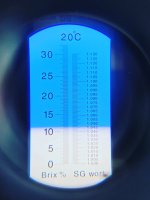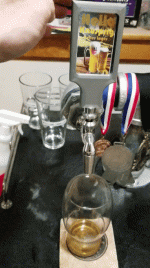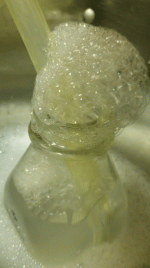The Shaving Cadre
You are using an out of date browser. It may not display this or other websites correctly.
You should upgrade or use an alternative browser.
You should upgrade or use an alternative browser.
TSC Homebrewing Thread
- Thread starter OpusX
- Start date
So original gravity is the specific gravity before any fermentation takes place?
Yes. Take original gravity and subtract specific gravity at the completion of fermentation and you have the abv. Basically.
OpusX
TSC’s Master of Warp Cores, Alchemy, Ale, & Cider
Traditional mead is around 12-14% ABV, so you're looking for a starting gravity near 1.100 (23.5 brix/plato). As @heysi most homebrewers use specific gravity as a measurement, mostly because of the common use of inexpensive hydrometers.3lbs of honey per gallon of water is a standard for making Mead? Is that a certain Brix %? Or do you not normally use that scale?
If you get fancy you can get a refractometer that shows both methods. They've gotten quite inexpensive.

Got it thanks. Yeah, I still have a hydrometer in my wine making stuff. I have used a refractometer in a previous job but never had one for homebrewing.Traditional mead is around 12-14% ABV, so you're looking for a starting gravity near 1.100 (23.5 brix/plato). As @heysi most homebrewers use specific gravity as a measurement, mostly because of the common use of inexpensive hydrometers.
If you get fancy you can get a refractometer that shows both methods. They've gotten quite inexpensive.
View attachment 110875
OpusX
TSC’s Master of Warp Cores, Alchemy, Ale, & Cider
I saw one on Amazon for $10.85 recently, so I would say yesNow....by "inexpensive", do you mean less than $50?
OpusX
TSC’s Master of Warp Cores, Alchemy, Ale, & Cider
Lets talk about lagers, and some fun with temperature.
Ales and lagers are generally defined by their yeasts being ales (“warmer” temps and top fermenting) lagers (“cooler” temps and bottom fermenting). For homebrewers most entry level beers are made as ales, as they tend to be fermented at your standard room temperatures (65-80F). Lagers tend to add the fun complexity of lower temperature regulation (40-55F) meaning the need for a fermentation chamber (aka fancy fridge) or seasonal brewing (using the garage during winter for example).
In the lazy world of homebrewing some adventurous folks have taken to “room temperature lagering” aka just using lager yeast at ale temps. Some popular yeasts have proven themselves quite adept to this technique, and in this brews case has worked out well.
My recent beer is a German Helles lager utilizing Fermentis 34/70 yeast. I originally pitched it a bit extra warm (69.8F) and left it in my basement (with my other brews) at about 67F for nearly 3 months of fermentation and “lagering” (a fancy word for letting gravity clear up the beer).
The warmer temps only help to produce more gentle floral esters, perfectly acceptable in a Helles, without any of the feared off flavors (sulfur for example). This was a very highly attenuated brew (aka it ate up all the sugar), going from 1.052 to 1.004, leaving me with a 6.3% summer crispy lager, just in time for the 4th.
Named this one “Hella Knusprig”. Now on tap and pouring well.

Ales and lagers are generally defined by their yeasts being ales (“warmer” temps and top fermenting) lagers (“cooler” temps and bottom fermenting). For homebrewers most entry level beers are made as ales, as they tend to be fermented at your standard room temperatures (65-80F). Lagers tend to add the fun complexity of lower temperature regulation (40-55F) meaning the need for a fermentation chamber (aka fancy fridge) or seasonal brewing (using the garage during winter for example).
In the lazy world of homebrewing some adventurous folks have taken to “room temperature lagering” aka just using lager yeast at ale temps. Some popular yeasts have proven themselves quite adept to this technique, and in this brews case has worked out well.
My recent beer is a German Helles lager utilizing Fermentis 34/70 yeast. I originally pitched it a bit extra warm (69.8F) and left it in my basement (with my other brews) at about 67F for nearly 3 months of fermentation and “lagering” (a fancy word for letting gravity clear up the beer).
The warmer temps only help to produce more gentle floral esters, perfectly acceptable in a Helles, without any of the feared off flavors (sulfur for example). This was a very highly attenuated brew (aka it ate up all the sugar), going from 1.052 to 1.004, leaving me with a 6.3% summer crispy lager, just in time for the 4th.
Named this one “Hella Knusprig”. Now on tap and pouring well.

Posts like this place me in danger of pulling out my old carboys, plugging in my basement fridge, and starting a lager... I don't need to fund any more hobbies, I don't need to fund any more hobbies, I don't need to fund any more hobbiesLets talk about lagers, and some fun with temperature.
Ales and lagers are generally defined by their yeasts being ales (“warmer” temps and top fermenting) lagers (“cooler” temps and bottom fermenting). For homebrewers most entry level beers are made as ales, as they tend to be fermented at your standard room temperatures (65-80F). Lagers tend to add the fun complexity of lower temperature regulation (40-55F) meaning the need for a fermentation chamber (aka fancy fridge) or seasonal brewing (using the garage during winter for example).
In the lazy world of homebrewing some adventurous folks have taken to “room temperature lagering” aka just using lager yeast at ale temps. Some popular yeasts have proven themselves quite adept to this technique, and in this brews case has worked out well.
My recent beer is a German Helles lager utilizing Fermentis 34/70 yeast. I originally pitched it a bit extra warm (69.8F) and left it in my basement (with my other brews) at about 67F for nearly 3 months of fermentation and “lagering” (a fancy word for letting gravity clear up the beer).
The warmer temps only help to produce more gentle floral esters, perfectly acceptable in a Helles, without any of the feared off flavors (sulfur for example). This was a very highly attenuated brew (aka it ate up all the sugar), going from 1.052 to 1.004, leaving me with a 6.3% summer crispy lager, just in time for the 4th.
Named this one “Hella Knusprig”. Now on tap and pouring well.
View attachment 113783
I'm a bit afraid of trying warm weather lagering. Of course, here in vegas, warm weather is in the low 100's. Until I can geta dedicated fermentation fridge, I'll have to stick to brewing in the fall and spring. Ale and Cider season is only 3 months away!!!
OpusX
TSC’s Master of Warp Cores, Alchemy, Ale, & Cider
You might note the lack of need for a fridge. See I'm helpingPosts like this place me in danger of pulling out my old carboys,plugging in my basement fridge, and starting a lager...
Ahhh well then you might like to know psuedo-lagers made with Lutra Kveik yeast allows for high fermentation temps, even in the 90sI'm a bit afraid of trying warm weather lagering. Of course, here in vegas, warm weather is in the low 100's
That's nuts!!!! I will investigate.even in the 90s
I just watched a video on how ABV is measured/calculated, so this makes sense to me now!going from 1.052 to 1.004, leaving me with a 6.3% summer crispy lager
He’s a riddle inside of a conundrum wrapped in a cheeseburger. Or something like that he’s always saying.Steven has no sense of adventure. Which is odd for a guy who claims to be into craft beer.
He's a Rubik's cube that someone took the stickers off and relabeled it, because they gave up trying to solve it after 5 minutes.He’s a riddle inside of a conundrum wrapped in a cheeseburger. Or something like that he’s always saying.
I'm a riddle inside a mystery, inside a conundrum wrapped in a hard candy shell. With a fancy pair of underwear on.He’s a riddle inside of a conundrum wrapped in a cheeseburger. Or something like that he’s always saying.



